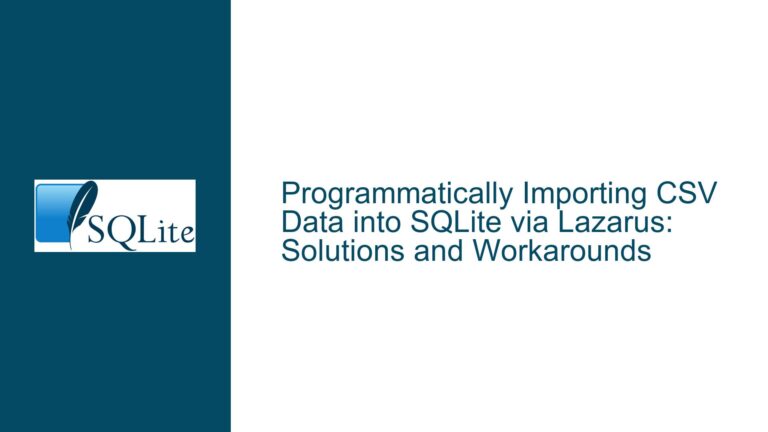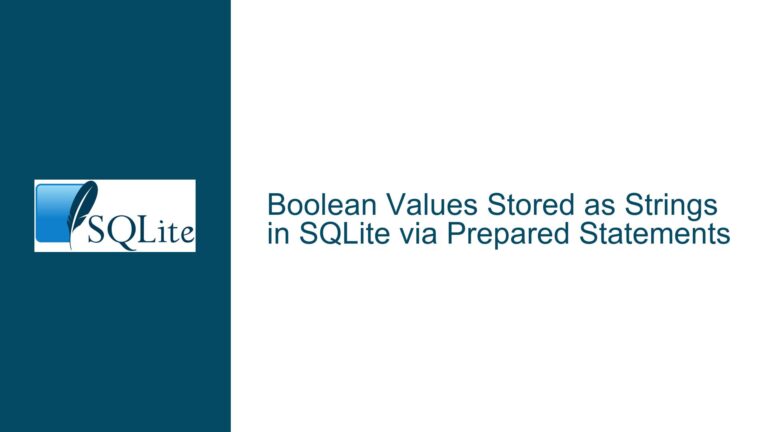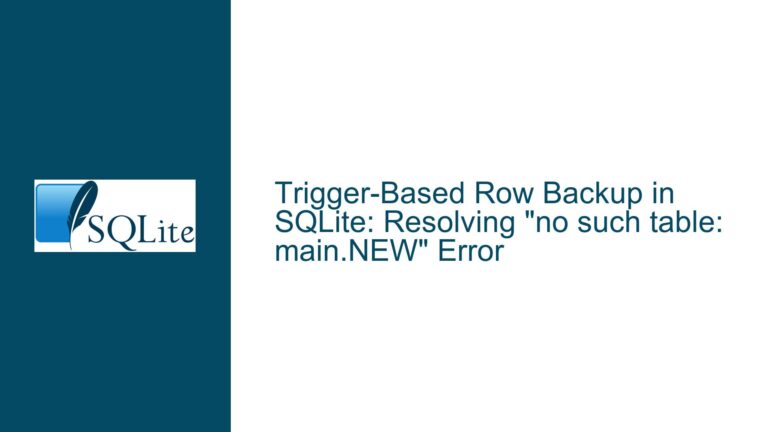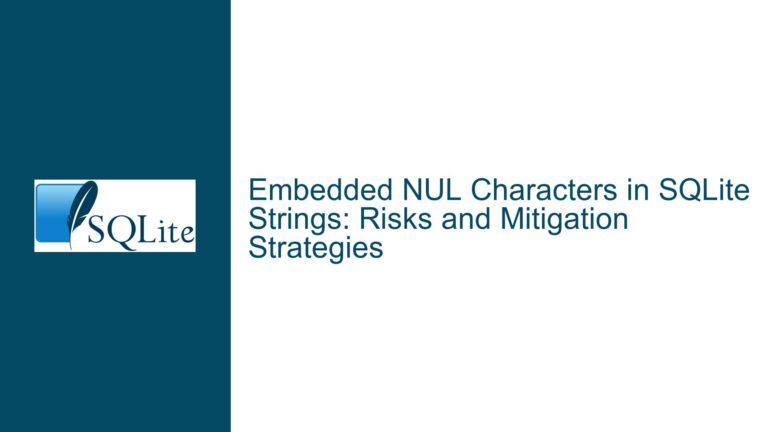Empty SQLite Database After pandas.DataFrame.to_sql Export
Transaction Commit Failure, DataFrame Integrity, and Schema Mismatch in pandas.to_sql Operations
Silent Transaction Rollback Due to Implicit pandas.to_sql Commit Behavior
The core issue arises when exporting a pandas DataFrame to an SQLite database using the to_sql method, resulting in an empty database despite apparent success in code execution. This occurs due to three interconnected factors: transaction management quirks in Python’s sqlite3 driver, undetected DataFrame creation failures from CSV sources, and schema definition conflicts during table creation. The interaction between pandas’ abstraction layer and SQLite’s transactional model creates non-obvious failure modes where data appears to persist but never materializes in physical storage. We observe this through empty tables in database viewers despite the absence of explicit error messages, requiring deep inspection of both pandas operations and SQLite’s transaction lifecycle.
Pandas’ to_sql method interacts unpredictably with SQLite’s default transactional behavior when using Python’s context managers. The SQLite connection remains in implicit transaction mode unless configured otherwise, causing all INSERT operations to remain in a pending state until explicit commit commands. Meanwhile, silent failures in CSV parsing may produce empty DataFrames that get written as zero-row tables, while column type mismatches between DataFrame dtypes and SQLite schema declarations can prevent successful table creation despite the if_exists="replace" parameter. These factors combine to create an empty database artifact that frustrates immediate diagnosis.
Diagnosis Methodology for Phantom Data Persistence Failures
Transaction Isolation Modes and Autocommit Configuration
Python’s sqlite3 driver defaults to isolation_level="DEFERRED", placing the connection in manual transaction mode. Every CREATE TABLE or INSERT statement initiates an implicit transaction that requires explicit commit before persisting to disk. The pandas library does not automatically issue commits after to_sql operations, assuming the connection handles transaction control. This creates a critical disconnect when using context managers (with sqlite3.connect(...) as con), as the connection’s __exit__ method only commits if no exceptions occur during the block. If to_sql encounters any errors during execution – even non-fatal ones like partial inserts – the entire transaction rolls back, leaving an empty table.
CSV Parsing Failures and DataFrame Integrity
The pd.read_csv function may return an empty or malformed DataFrame without raising exceptions when faced with irregular data formats. Common failure points include:
- Mismatched column counts between header row and data rows
- Inconsistent quoting/escaping in CSV fields
- Silent type coercion errors in
dtypeparameter usage - File path errors causing empty DataFrame creation
These issues produce a valid DataFrame object that contains no usable data, whichto_sqlwill happily write as an empty table. Thelow_memory=Falseparameter in the given code exacerbates memory issues with large CSVs, potentially causing incomplete reads.
Primary Key Conflicts and Schema Replacement Edge Cases
The dtype={"column": "INTEGER PRIMARY KEY"} parameter attempts to define a primary key during table creation. However, pandas’ schema inference logic conflicts with explicit dtype overrides in several ways:
- If "column" doesn’t exist in the DataFrame, SQLite creates it as
NULL, violating primary key constraints - Implicit rowid aliasing when using
INTEGER PRIMARY KEYrequires the column to be autoincrementing - Table replacement (
if_exists="replace") drops existing tables but may fail to recreate them if new schema constraints conflict with DataFrame contents
This schema mismatch causes silent table creation failures where the parametros table either lacks the primary key constraint or isn’t recreated properly after being dropped.
Comprehensive Validation and Correction Protocol
Step 1: Validate DataFrame Integrity Pre-Export
Before attempting SQLite export, rigorously verify the DataFrame’s structure and contents:
# Check DataFrame loading diagnostics
print(f"DataFrame shape: {laudos_cru.shape}")
print(f"Columns: {laudos_cru.columns.tolist()}")
print(f"First 5 rows:\n{laudos_cru.head(5)}")
print(f"Data types:\n{laudos_cru.dtypes}")
print(f"Null value counts:\n{laudos_cru.isnull().sum()}")
# Verify CSV file metadata
csv_path = os.path.join("path_to_csv", "filename.csv")
print(f"CSV file size: {os.path.getsize(csv_path)} bytes")
with open(csv_path, 'r') as f:
sample_content = f.read(1000)
print(f"CSV sample:\n{sample_content}")
Critical Checks:
- Confirm
shape[0] > 0(non-zero rows) - Validate that all expected columns appear in
columns - Ensure numeric columns don’t contain non-null object dtypes
- Check for UTF-8 encoding issues in string columns
- Verify CSV file isn’t empty or truncated
Step 2: Enforce Transaction Commit and Connection Settings
Modify the SQLite connection setup to either enforce autocommit mode or explicitly commit transactions:
Option A: Autocommit Mode Configuration
# Set isolation_level=None to enable autocommit
with sqlite3.connect(arquivo_db, isolation_level=None) as con:
laudos_cru.to_sql(
"parametros",
con,
index=False,
if_exists="replace",
dtype={"column": "INTEGER PRIMARY KEY"},
)
# Explicit commit still recommended despite autocommit
con.commit()
Option B: Manual Commit Control
# Use explicit commit() outside transaction context
con = sqlite3.connect(arquivo_db)
try:
laudos_cru.to_sql(
"parametros",
con,
index=False,
if_exists="replace",
dtype={"column": "INTEGER PRIMARY KEY"},
)
con.commit()
finally:
con.close()
Rationale:
isolation_level=Nonedisables SQLite’s implicit transactions- Explicit
commit()ensures all pending writes flush to disk - Context managers alone don’t guarantee commit on
to_sqlerrors
Step 3: Schema Reconciliation and Primary Key Handling
Resolve column type mismatches and primary key constraints:
A. Validate Primary Key Column Existence
Ensure the DataFrame contains the column specified in dtype:
assert "column" in laudos_cru.columns, \
"Primary key column missing from DataFrame"
B. Coerce Primary Key Compatibility
Force primary key column to compatible numeric type:
laudos_cru["column"] = pd.to_numeric(
laudos_cru["column"],
errors="coerce"
).astype("Int64")
C. Schema Generation Debugging
Inspect generated table schema using PRAGMA table_info:
with sqlite3.connect(arquivo_db) as con:
cursor = con.cursor()
cursor.execute("PRAGMA table_info(parametros)")
schema = cursor.fetchall()
print("Table schema:", schema)
Expected Output:
Table schema: [
(0, 'column', 'INTEGER', 0, None, 1),
(1, 'column1', 'INTEGER', 0, None, 0),
...
]
Verify primary key (pk=1) designation exists on intended column.
Step 4: Alternative Export Pipeline Validation
Bypass pandas entirely to isolate the issue using native SQLite CSV import:
import sqlite3
import subprocess
# Create empty database
with sqlite3.connect(arquivo_db) as con:
pass # Ensure clean DB
# Import CSV via SQLite CLI
subprocess.run([
"sqlite3",
arquivo_db,
f".mode csv\n.import {csv_path} parametros\n"
])
Analysis:
- If SQLite CLI import succeeds, the issue lies in pandas CSV handling
- If CLI import fails, inspect SQLite error for CSV format issues
Step 5: Low-Level SQLite Diagnostic Queries
Execute direct SQL queries to audit database state:
Check Table Existence:
with sqlite3.connect(arquivo_db) as con:
cursor = con.cursor()
cursor.execute("SELECT name FROM sqlite_master WHERE type='table'")
print("Tables:", cursor.fetchall())
Verify Row Counts:
cursor.execute("SELECT COUNT(*) FROM parametros")
print("Row count:", cursor.fetchone()[0])
Inspect Indexes and Constraints:
cursor.execute("PRAGMA index_list(parametros)")
print("Indexes:", cursor.fetchall())
Step 6: pandas.to_sql Parameter Tuning
Adjust to_sql parameters for compatibility:
A. Chunked Writes for Memory Efficiency
laudos_cru.to_sql(
"parametros",
con,
index=False,
if_exists="replace",
dtype={"column": "INTEGER PRIMARY KEY"},
chunksize=1000, # Adjust based on DataFrame size
method="multi" # Batch insert
)
B. Disable Foreign Key Constraints During Import
with sqlite3.connect(arquivo_db) as con:
con.execute("PRAGMA foreign_keys=OFF")
laudos_cru.to_sql(...)
con.execute("PRAGMA foreign_keys=ON")
C. Explicit Data Type Mapping
dtype_mapping = {
"column1": "INTEGER",
"column2": "TEXT",
"column3": "TEXT",
"column4": "TEXT", # SQLite lacks dedicated OBJECT type
}
Step 7: Filesystem and Permission Audits
Verify database persistence at OS level:
Check Database File Properties:
print(f"DB path: {os.path.abspath(arquivo_db)}")
print(f"DB exists: {os.path.exists(arquivo_db)}")
print(f"DB size: {os.path.getsize(arquivo_db)} bytes")
Validate Write Permissions:
test_path = os.path.join("path", "write_test.txt")
try:
with open(test_path, "w") as f:
f.write("test")
os.remove(test_path)
except PermissionError as e:
print(f"Write permission denied: {e}")
Step 8: Cross-Validation with pandas.read_sql
Confirm round-trip integrity by reimporting data:
with sqlite3.connect(arquivo_db) as con:
df_roundtrip = pd.read_sql("SELECT * FROM parametros", con)
print(f"Roundtrip DF shape: {df_roundtrip.shape}")
pd.testing.assert_frame_equal(laudos_cru, df_roundtrip)
Final Integration: Hardened Export Implementation
Combining all fixes into a robust implementation:
import sqlite3
import pandas as pd
import os
# Configurable paths
base_dir = "verified_path"
csv_name = "validated_data.csv"
db_name = "BaseTeste.db"
# Construct absolute paths
csv_path = os.path.abspath(os.path.join(base_dir, csv_name))
db_path = os.path.abspath(os.path.join(base_dir, db_name))
# Load CSV with enhanced validation
try:
laudos_cru = pd.read_csv(
csv_path,
sep=",",
dtype={
"column1": "Int64",
"column2": "string",
"column3": "string",
"column4": "object",
},
header=0,
on_bad_lines="error",
engine="python",
encoding_errors="strict",
)
except pd.errors.ParserError as e:
raise SystemExit(f"CSV parsing failed: {e}")
# Verify non-empty DataFrame
assert not laudos_cru.empty, "DataFrame is empty after CSV load"
# Configure SQLite connection with autocommit
conn = sqlite3.connect(db_path, isolation_level=None)
try:
# Disable foreign keys during replace
conn.execute("PRAGMA foreign_keys=OFF")
# Export with explicit transaction control
laudos_cru.to_sql(
name="parametros",
con=conn,
index=False,
if_exists="replace",
dtype={"column": "INTEGER PRIMARY KEY"},
chunksize=1000,
method="multi"
)
# Commit and clean up
conn.commit()
conn.execute("VACUUM") # Compact database
finally:
conn.close()
# Post-export verification
with sqlite3.connect(db_path) as vconn:
vconn.row_factory = sqlite3.Row
cursor = vconn.execute("PRAGMA table_info(parametros)")
schema = [dict(row) for row in cursor.fetchall()]
print("Final schema:", schema)
row_count = vconn.execute("SELECT COUNT(*) FROM parametros").fetchone()[0]
print(f"Inserted rows: {row_count}")
This hardened implementation incorporates:
- Absolute path resolution to prevent directory ambiguity
- Strict CSV parsing with error termination
- DataFrame emptiness validation
- Transaction isolation disabled for autocommit
- Foreign key constraint disabling during table replacement
- Batched inserts for memory efficiency
- Post-export vacuuming to ensure data flush
- Schema and row count verification
Persistent Failure Resolution Pathways
Case 1: Empty Database Despite Fixes
If the database remains empty after applying all fixes:
- Use
sqlite3command-line tool to inspect database:sqlite3 BaseTeste.db \ ".tables" \ "PRAGMA table_info(parametros)" \ "SELECT COUNT(*) FROM parametros" - Check system logs for filesystem errors (e.g.,
dmesg,journalctl) - Test with in-memory database to isolate filesystem issues:
with sqlite3.connect(":memory:") as con: laudos_cru.to_sql(..., con=con) print(pd.read_sql("SELECT * FROM parametros", con))
Case 2: Intermittent Data Persistence
If data appears sometimes but not consistently:
- Monitor database file inode changes during writes:
watch -n 0.1 "stat -c '%i' BaseTeste.db" - Check for multiple processes accessing the database
- Enable SQLite’s Write-Ahead Logging (WAL) mode:
with sqlite3.connect(arquivo_db) as con: con.execute("PRAGMA journal_mode=WAL")
Case 3: Schema Mismatch Errors
For persistent primary key or column type issues:
- Generate SQL schema from pandas and compare:
from pandas.io.sql import get_schema print(get_schema(laudos_cru, "parametros", con=conn)) - Manually execute schema creation SQL:
schema_sql = get_schema(laudos_cru, "parametros", con=conn) with sqlite3.connect(arquivo_db) as con: con.executescript(schema_sql)
Conclusion
The emptiness of the SQLite database after using pandas.DataFrame.to_sql stems from intricate interactions between pandas’ abstraction layer and SQLite’s transactional model. By systematically validating each component of the data pipeline – from CSV ingestion to SQL schema generation – developers can isolate and resolve persistence failures. Key remedies include enforcing explicit transaction commits, rigorous DataFrame validation, and low-level database integrity checks. The provided troubleshooting protocol establishes a robust framework for diagnosing and resolving similar data export issues across diverse deployment environments.






